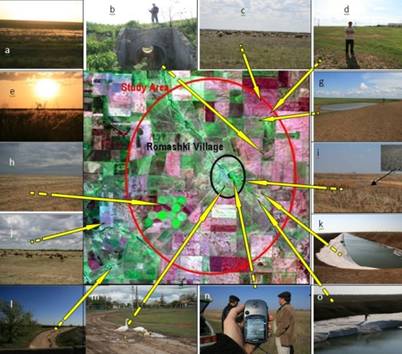Location description
Collective farm of Romashki village (50°11,77' N, 46°40,36' E) was established in 1944 year and has around 33 300 ha of land (21,3 103 ha of arable lands). Main productions of this farm are meat, wool (sheep, fig. 2. c, d), milk (fig. 2 j) and cereals. This farm is one of two biggest farms of sheep breeding in the Pallasovsky district. In crop production main growing species are cereals, mustard and rye. However, these activities request an adequate territory and their management that is not always satisfied. Due to overgrazing of the pasture there are some processes of land cover lost and as consequence- soil water erosion.

Fig. 2: Study plot at the territory of Romashki village.
At XIX century German settlements developed a huge earth-made system for snow retention to store water melted from snow in soil layer to be used for crop growing during vegetation period time. Actually, these systems are almost degraded and don't provide a full service (fig. 2 b). Constructed during second part of previous century an irrigation system was recognized as not efficient for nowadays market economy due to high price for supplied water price and was abandoned (fig. 2 h). As consequence pumping of water canal was stopped up (fig. 2 l) that blocked also water supply for household use including gardening. Water ponds that were constructed for local surface water retention of about 1 km3 capacity and collective use for recreation and for growing of domestic national bird, fish breading and as water place for stock (fig. 2 m) are almost empty (fig. 2 g, i) due to increased surface water infiltration rate fed these ponds. A special ground water reservoir (fig. 2 k, o) was constructed with explosion technology during soviet time) as water place for stock was designed for the use of mix of fresh surface water and mineralized groundwater (about 7-15 g/l). During last ten years due to decreasing of groundwater table (for about 2 m at local scale) it has not enough capacity to provide enough water during all needed time. Some of cited water resource degradation process can be explained by change of seasonal patterns of local climate (i.e. rain during late autumn instead of snow that diminish a depth of frozen soil), longtime drought, and consequences of ruining of irrigation system using .
During summer time water for domestic use is supplied in the big cistern tracked by car. In such conditions local peoples are very limited in the use of their garden parcel for vegetable growing.
Degradation of land and water resources affects people's income by decreasing food production (yields become lower and lands become abandoned due to salinization of them). The young generation is leaving rural areas due to level of life and possibilities to find more income in the urban area. Lack of information about sustainable land management, climate instabilities and weak institutional support with low financial support from the governmental organization make the life of people in this region difficult.
Main income of the stakeholders from the study site (Romashki) is a agricultural production from their garden plots (fruits and vegetables), growing cattle (sheep and cows). There is a big agricultural conglomeration - farm "Romashkovsky". A number of people are working in this farm and their salary depends on its production.